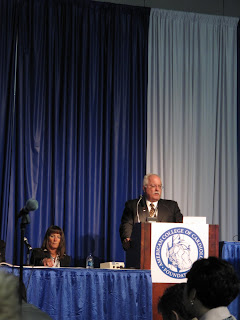The Institute for Healthcare Improvement (IHI) was my major stop the next day in Boston. This organization is a very interesting one that may play an important role in the healthcare reform. On April 19, President Obama nominated the CEO of IHI, Dr. Donald M. Berwick, to run the Medicare and Medicaid Service (CMS) which serve nearly one-third of all Americans. Founded in 1991 and based in Cambridge, Massachusetts, IHI works to improve health care quality while reducing its cost. This nomination personifies Mr. Obama’s determination to forge some new ideas in the new health care law.
As Madge Kaplan, the director of communications in IHI, told me while she took me on a tour of IHI’s headquarters in Boston, this organization is very positive and optimistic. People are working in an open and transparent office environment, and the sunshine coming through the big window makes the large space bright. Walking down aisle close to the window, I read IHI’s ambitious goals—the “no needless list” adapted from the IOM’s six improvements: no needless deaths, no needless pain or suffering, no helplessness in those served or serving, no unwanted waiting, no waste and no one left out—which are printed on the pillars. On the other side of the aisle, a poster board shows energy and water saving fact sheets that explain for what the staff did.
It is very interesting for me to know that IHI began its work with some little and simple things, rather than with some complex, high-tech, and extremely costly programs. Rather than spend huge amount of money to develop the advanced technique, what IHI does is more like cultivating ideas for improvement. One simple example is helping nurses save time when looking for things and making the flow of hospital work more effective. As a result, they don’t have spend too much time running from floor to floors, answering phones, or doing paper works; instead, this precious time can be devoted to patients who really need it.
Another renowned idea is Dr. Atul Gawande’s “checklist.” Gawande has been named one of the 2010 Time 100 people for the success of his the best-selling book—“The Checklist Manifesto.”This is all about a reminder sheet to be used by a surgery team to make double-check everything right before an operation. Since this national campaign is well known, you can check for more details online. I would still like to cite Ms. Kaplan’s words as the central message for this program—“our goal here is the patient, not your ego.”
The new innovative program in IHI is the hospital Improvement Map. It is an interactive tool to guide hospitals to take actions to improve their management according to their interests and situation. For me, it is more like an idea library which collects and distills all the best knowledge available on the key process improvements. And a hospital could choose the best idea that matches its need. Or, you can call it a map, if you prefer, which will lead you to choose the best way to the final goal—better health care. To better understand it, check it out.
IHI is growing, not only nationwide, but also worldwide. IHI has an international forum every year which draws almost 6,000 people, and also has cooperation campaigns in many other countries, such as the UK and Japan. Although currently there is no connection with China, I believe there will be in the not so distant future.











